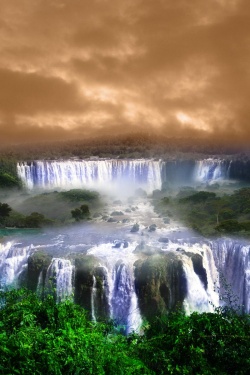
|
The Jedi were real? This article is part of the history of Clan Odan-Urr and isn't part of current events.
Please do not remove this tag or the contents. These articles exist for historic purposes.
|

|
| Takawai
|
|
humid
|
|
|
|
Harakoans, Mon Calamari
|
|
|
|
|
|
None
|
|
None
|
|
Odan-Urr
|
Takawai, meaning "Waterfall" in Harakoan is a naturally-formed waterfall created millions of years ago on the eastern borders of the continent Milil’ea. Perhaps the largest naturally-formed waterfall in Harakoa, Takawai is considered one of the greatest wonders of New Tython. Due to the extremely humid climate created by the mist surrounding the falls, this site holds the single largest Mon Calmari population in all of New Tython. Being a main sight for tourists, the Mon Calamari and Harakoans taking up residence near the falls have created what is called the "Mauri Wai Festival" in which the expansive pools below the falls are open to the general public.
The Takawai
Origins
The Takawai was created hundreds of millions of years ago in Milil’ea as a result of a shift in Harakoa's tectonic plates. With the highest total vertical drop of the largest waterfall that is part of the Takawai, the falls are measured at 440 metres (1443 ft) tall. It is also noted as the starting point of most of the rivers expanding across Milil’ea, directly branching off into the three main rivers that flow across the eastern side of the continent after the massive pool situated at the base of the falls. The water in this massive pool contains mostly salt water carried down from the surrounding ocean. It is situated on the far eastern side of the continent, where it brings in water from the surrounding ocean to the streams and rivers dotting the continent.
Harakoan Occupation
Originally, the Takawai had been reserved exclusively for Harakoan of New Tython before the planet had been populated by other species. During this time, the Harakoans celebrated the "life water" that the falls brought into the continent. The elders would cleanse the water in Harakoan rituals and bathe, as per a tradition passed down over countless generations of Harakoans. The Harakoans also built a small settlement nearby the falls in order to maximize efficiency when sending out tribesmen to gather water or food from the plants that grew along the banks of the separated rivers. Eventually, however the Harakoans had relocated the bulk of their tribe further from the falls as Mon Calamari settlers took residence nearby the Takawai. In exchange, the Mon Calamari have agreed to openly trade with the Harakoan tribes as well as permit a small population to reside nearby the falls, as well as continue their traditions in what would become the "Mauri Wai Festival".
Mon Calmari Occupation
In recent days, the Mon Calamari have amassed a major settlement around the base of the falls, along with a smaller population of Harakoans. Because of the Calmari's preference to water abundant areas, they have made many agreements with the neighbouring Harakoans tribes for permission to use the land around the base of the falls. Many of these Calamari are excellent craftsmen and trained pilots who have mastered the art of ship building. These Mon Calamari tend to welcome tourists with much enthusiasm who take the journey to see the falls for themselves.
Mauri Wai Festival
The Mauri Wai Festival is a celebration that occurs once every week. Mauri Wai means "Life Water" in Harakoan tongue and is the celebration of the life that the water gives to Harakoans, as well as the various species of plants and creatures throughout the continent. During this event, Harakoan elders will perform a highly complex cleansing ritual on the water at the base of the waterfalls. At the end of the ritual, the elders will bathe in the salt abundant waters at the base of the falls.
During the remainder of the festival, both Harakoans and Mon Calamari alike set up various vendor stalls of bamboo along the shore of the expansive pool, selling goods and memoralbilia to visitors from all over New Tython. Such items sold may include vials of cleansed water from the base of the falls, or varying Mon Calamari and Harakoan works of art, such as hand-carved statues of various Harakoan cheiftans and elders carved from driftwood that makes it over the falls. To take advantage of the large waterfalls, the Mon Calamari have constructed a massive set of wooden platforms and stair leading to the top of the falls. Although rarely braved, the long journey reveals an astonishing view of Milil’ea as one peers over the falls. This breathtaking vista is amplified by the rushing torrent of water below their feet as it makes its way down the massive drop over the edge of the falls.
At night, the festivities continue with Harakoan fire dancers and fine Mon Calamari cuisine as the sun sets. As one continues down the shore line, they may see the light of torches as Harakoans march down the shoreline as the Harakoans continue in a night-time parade down the wide bank along the large salt-concentrated pool aaround the falls. In this parade, Harakoan tribesmen march down the shoreline in a ritualistic dance wearing facepaint and carrying torches. At the end of the parade, one may catch a glimpse of the elders and the cheiftan as they are escorted by Harakoan soldiers, disappearing as they enter the thick forests towards the relocated Harakoan settlement, marking the end of the festivities.